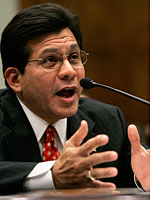Prospect Profile: Eduardo Nunez
(I'm testing out a new profile format, so tell me what you think. I'm thinking about redoing some of my earlier profiles, which frankly suck, in this format.)
Age: 19 (20 in June)
Height: 6'0"
Weight: 170 lbs
Drafted: Signed as an undrafted free agent in 2004 at age 16.
Position: Shortstop
Throws: Right
Bats: Switch
Offense: Nunez opened a lot of eyes by hitting .313/.365/.427 for Staten Island in 2005 at the age of 18. Staten Island is a really funky place to hit. Based on BBTF's Minor League Park Factors, the park does not make it harder to hit a double, home run, or single, but has a .87 park factor - among the lowest in the minors, and roughly equal to PETCO's park factor in 2006. The weather and sun conditions in Staten Island make it a lot easier for pitchers to strike hitters out. For this reason, Nunez's line was pretty amazing. PECOTA jumped on him, and Nunez shot up everyone's depth charts. The Yankees sent him straight to Tampa, where Nunez categorically flopped. He hit .184/.223/.340, showing power but not much else. He was striking out like he did not in Staten Island (28 in 37 games vs 43 in 73). He didn't do much else when he was sent down to Charleston, hitting .227/.278/.294. Nunez has good offensive potential, but 2006 may have proven that 2005 was a just luck.
Defense: Nunez is a shortstop, with plenty of arm strength and range, but is still learning how to use his skills. As is typical with shortstops his age, Nunez needs to work on footwork and consistency. He has been struggling defensively, but most people believe that he will eventually become a very good defender at the position. The Yankees will not attempt to move Nunez from shortstop any time soon. They have a wealth of players at 2nd base and centerfield, and can afford to be patient with the very young Nunez.
Health: Nunez stayed healthy in 2006, playing 127 games. His struggles were not caused by injury.
Comparison: I think that Nunez has the potential to become a Felipe Lopez type hitter.
My Take: Nunez was rushed to Tampa in 2006, there is no question. His placement there was less of an endorsement of his advanced style and more of a neccessity brought on by first round pick C.J. Henry's level of rawness. The Yankees did not want to slow down Henry down by alternating the two at Charleston, or sending Henry to a short season league. So they gambled on Nunez (and Battle, and Vechionacci) and got hosed. He was way too young for his league - a league and a ballpark which traditionally murder hitters. He may have gotten a little unlucky (.197 BABIP), but there were few bright spots in his performance except for a .268/.318/.439 line with runners in scoring position. There might be some future brightness signified by his .340 slugging average despite hitting just .184. In the Florida State League, that is some serious power (5 2b, 3 3b, 4 HR in 37 games, 21/13/17 over 155 games), but the lack of plate discipline is very concerning. Nunez is going to have to learn to walk to go with his good strikeout rate (career 119 K in 200 games). I didn't rank Nunez top-30 because I am not sold that his batting average driven 2005 is the real Nunez. He didn't hit in the DSL in 2004, and only showed faint glimmers of hitting ability in 2006.


